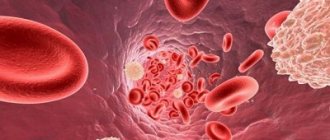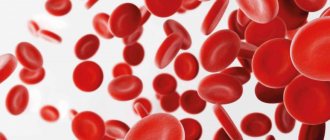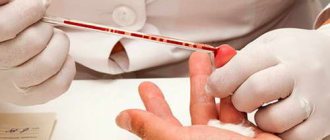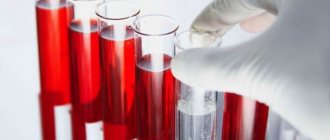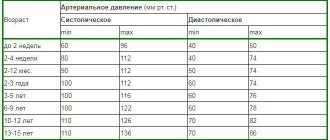Published: 03/30/2021 17:00:00 Updated: 03/30/2021
Erythrocytes are red blood cells, the most numerous blood cells. Formally, they are not cells, since during the process of maturation they lose many of the structures necessary for cells. For example, they lack nuclei and do not synthesize any protein molecules, unlike other cells in the body. So the name “cell” in this case is used for convenience. Red blood cells are formed in the bone marrow and constantly circulate in the body, performing the most important function of maintaining life - they carry oxygen from the lungs to tissues and organs and remove carbon dioxide.
In addition to red blood cells, blood contains plasma, platelets, and leukocytes. However, the number of red blood cells is so large that just a couple of drops of blood contains about one billion of these cells. They make up about 40% of the total blood volume. Actually, it is red blood cells that give our blood its characteristic red color due to its hemoglobin content.
Red blood cells do not last forever, they wear out over time and eventually die. The average life cycle of a red blood cell is approximately 120 days—a total of four months. However, do not worry, the bone marrow is constantly producing new cells and maintaining the required level of red blood cells. Various unfavorable circumstances can reduce or, conversely, increase their reproduction rate and affect their life expectancy - thus, the balance of blood composition is disrupted. An increase or decrease in red blood cells is associated with various pathological conditions. Let's consider this issue in more detail.
Red blood cells are normal
The normal limits vary depending on gender, age and other characteristics.
So, for an adult man it ranges from 4.0 to 5.1 × 10¹² units per liter of blood, and for women - 3.7 to 4.7 × 10¹² per liter.
In pregnant women, red blood cells may decrease to 3–3.5 x 10¹² per liter.
In children under one year of age, the concentration of red blood cells is constantly changing, so to assess the composition of their blood there is a special table that doctors use when interpreting tests.
In childhood, after one year there are still slight deviations from the “adult” norm, but by adolescence the level of red blood cells levels out.
Reduced number of red blood cells in a woman's blood
Anemia or hypodermia may be indicated by a reduced number of red blood cells in the blood. Similar analysis indicators are recorded in people who have lost a lot of blood. If a pregnant woman takes diuretics in the first stage of pregnancy, then the number of blood cells in her blood also decreases significantly. One of the reasons for the reduced number of red blood cells in the blood may be their too active destruction or poor functioning of the bone marrow in their reproduction.
Elevated red blood cells
Red blood cells can be elevated due to many reasons, ranging from banal dehydration to erythremia - chronic leukemia.
Therefore, if there are any deviations in test results, you should consult a specialist to determine the cause. An increase in the number of red blood cells is called erythrocytosis, which can be: 1. Primary. A rare hereditary disease characterized by loss of energy, dizziness and darker color of the mucous membranes. 2. Secondary. Caused by other diseases or conditions (for example, smoking or staying in high mountains) and is associated with oxygen starvation of cells.
Thus, the following reasons for the increase in red blood cells can be identified:
- Dehydration. When the volume of fluid in the body is reduced, the percentage of red blood cells (and other blood cells) artificially increases.
- A lack of oxygen, which the body tries to compensate by producing more red blood cells.
- Congenital heart defect. If the heart cannot pump blood effectively, the amount of oxygen reaching the tissues is reduced. The body creates more red blood cells to compensate for oxygen deprivation.
- Genetic causes (changes in sensitivity to oxygen, impaired release of oxygen by hemoglobin).
- Polycythemia vera is a rare disease in which the body produces too many red blood cells.
Increased production of red blood cells can cause blood to thicken, slow blood flow, and related problems (eg, headaches, dizziness, vision problems, excessive blood clotting).
Often, elevated red blood cell levels are due to dehydration, hot weather, extreme stress, or excessive exercise. A pathological increase in red blood cells is a fairly rare pathology. Much more often, patients encounter reduced levels.
Red blood cells in urine: normal
Normally, there should be no red blood cells in the urine, even in minimal quantities. These are red cells that are found only in blood vessels. They do not pass into the bladder or ureter, and therefore should not be contained in the urine. But in isolated cases, deviation from the norm is acceptable.
Red blood cells can be found in small quantities in the urine due to the following consequences:
- strong physical activity;
- alcohol abuse;
- long period of work literally on your feet;
- certain pathologies;
- too frequent use of spices in food.
Normally, in the urine of both men and women, only 1, 2 or 3 red blood cells can be observed in the field of view. If in fact there are more of them, in many cases this indicates the development of pathology.
Decreased red blood cells
The main symptoms of low red blood cell count are:
- Weakness or fatigue.
- Lack of energy.
- Paleness of the skin.
Reduced red blood cells are a relatively common pathology.
A low number of red blood cells and/or hemoglobin is called anemia. If there are few red blood cells, there is correspondingly less hemoglobin in the bloodstream, which carries oxygen. Thus, the body experiences oxygen starvation, and we feel weakness, drowsiness, loss of vitality, and dizziness. Due to anemia, hair falls out, the skin becomes pale and dry. There are many forms of anemia, each with its own cause. Anemia can be temporary or acquired; depending on severity - from mild to severe. According to a 2015 publication in The Lancet, about one-third of the world's population is anemic.
The most common causes of low red blood cells are:
- Unbalanced diet with deficiency of iron, vitamin B12 or folic acid.
- Damage to the bone marrow (toxins, radiation or chemotherapy, infection, certain medications).
- Any bone marrow disease.
- Chronic inflammatory processes.
- Bleeding in the digestive tract (for example, from ulcers, polyps, colon cancer).
- Heavy menstrual bleeding.
- Trauma with massive blood loss.
- Conditions that cause the destruction of red blood cells (for example, hemolytic anemia caused by autoimmune processes or defects in the red blood cells themselves).
- Kidney failure – serious kidney pathologies lead to a decrease in erythropoietin (or hematopoietin), a kidney hormone that promotes the production of red blood cells.
The risk of anemia is higher in the following groups:
- children aged from 6 months to 2 years;
- pregnant or recently given birth women;
- following a diet low in vitamins, minerals and iron, red meat;
- patients who regularly take medications that cause inflammation of the gastric mucosa (for example, ibuprofen);
- having a family history of hereditary anemia such as sickle cell anemia or thalassemia;
- patients with an intestinal disorder that affects the absorption of nutrients (eg, Crohn's disease);
- have recently experienced major blood loss due to surgery or injury;
- people with chronic diseases (HIV, diabetes, kidney disease, cancer, rheumatoid arthritis, heart failure, liver disease).
Deviation from the norm is not always a disease
If the level of red blood cells during the first analysis is slightly outside the normal range, do not panic.
Your doctor will help you interpret the results correctly, taking into account your individual characteristics and medical history. A single slightly elevated or slightly decreased result may have no medical significance. There are several factors that can cause a test result to fall outside the established reference range without pathological reasons:
- Under the influence of external factors (stress, previous infections, physical activity), the results of the analysis of the same person may differ slightly. In this case, a person can be healthy. If the analysis shows a slight deviation, retake the test on another day.
- Individual characteristics. For some people, the boundaries of the norm may differ slightly from generally accepted ones. Reference values are valid for the vast majority of people, but we are all different, and in some rare cases, a healthy person may have their own norms, slightly different from the usual values.
Only a doctor can accurately determine this after conducting additional research.
Why are red blood cells in urine elevated?
The reasons for the appearance of blood cells in the urine can be very different. For convenience, they are divided into 3 groups:
- Somatic (prerenal) - they are associated not with the excretory system, but with other organ systems.
- Renal – occur against the background of kidney pathologies.
- Postrenal – associated specifically with the excretory system.
If we talk in more detail about the somatic group, we can highlight the following reasons:
- Thrombocytopenia is a decrease in the concentration of platelets in the bloodstream. This leads to blood clotting disorders, which causes red blood cells to end up in the urine.
- Hemophilia is a deterioration in blood clotting, due to which it thins out and also penetrates into the urine.
- Poisoning of the body, for example, due to a bacterial or viral infection.
The main reasons of a renal nature:
- Glomerulonephritis of acute or chronic nature.
- Kidney cancer - the tumor increases in size and destroys the wall of the vessel.
- Urolithiasis – due to stones, the mucous membrane is destroyed.
- Pyelonephritis - inflammation leads to impaired permeability of the blood vessels of the kidneys.
- Hydronephrosis - poor urine flow leads to damage to the walls of blood vessels.
Postrenal causes:
- Cystitis is an inflammatory process in the bladder that causes blood cells to leak into the urine.
- A stone in the ureter, bladder and, as a result, damage to the mucous membrane.
- Bladder cancer damages the walls of blood vessels.
Separately, gender-related reasons can be identified. Thus, in men, pathology is often observed against the background of:
- Prostatitis is an inflammatory process that affects the tissue of the prostate gland. It leads to the entry of red cells into the urine in large quantities, which clearly indicates pathology.
- Prostate cancer – a tumor appears that increases in size and begins to put pressure on the walls of blood vessels. They receive damage through which cells leak.
In women, the cause may be:
- Uterine bleeding - sometimes as a result of injuries, blood from the vagina enters the urine directly when visiting the toilet.
- Cervical erosion - a wound appears on the uterine mucosa, often due to traumatic exposure, sexually transmitted infections or hormonal imbalance. As a result, secretions are released, including those mixed with blood, which ends up in the urine.
Tests for red blood cells
A red blood cell count and cell count is usually done as part of a complete blood count (CBC).
A general blood test is the most common analysis, informative for almost any pathological process. This test can also be used to diagnose and/or monitor a number of diseases that affect the production or lifespan of red blood cells. You can take a general blood test with determination of 5 fractions of leukocytes at any CityLab medical center.
For an accurate diagnosis, the doctor may prescribe additional tests:
- Reticulocyte count - determines the number of immature red blood cells.
- Iron test - this trace element plays an important role in the production of red blood cells.
- Vitamin B12 and folic acid levels – these vitamins are also important for red blood cell production.
- A blood test for ferritin reflects iron reserves in the body.
- Serum iron, total iron-binding capacity of blood serum are additional parameters reflecting the process of iron metabolism in the body.
Author:
Baktyshev Alexey Ilyich, General Practitioner (family doctor), Ultrasound Doctor, Chief Physician
The norm of red blood cells in tests in adults
On blood test forms, red blood cells are designated by the Latin abbreviation RBC.
The normal number of red blood cells depends on gender and age.
- For men 18-45 years old it is 4.3 x 1012 - 5.7 x 1012 / l, and for women 18-45 years old it is 3.8 x 1012 - 5.1 x 1012 / l.
- For men 45-65 years old it is 4.2 x1012 - 5.6x1012 /l, and for women 45-65 years old it is 3.8 x1012 - 5.3x1012 /l.
- For men over 65 years old it is 3.8 x 1012 - 5.8 x 1012 / l, and for women over 65 years old it is 3.8 x 1012 - 5.2 x 1012 / l.
Young forms of red blood cells are called reticulocytes. Normally, their content in the blood should not exceed 0.2-1.2% of the total amount. An increase in the content of reticulocytes in the blood (reticulocytosis) in the treatment of anemia caused by a lack of vitamin B12 in the body is an early sign of recovery.

